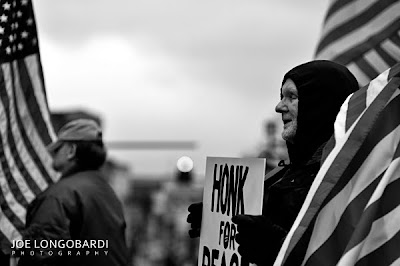After the War: The Grassroots Peace Movement in the United States
Marking the 7 year anniversary of the invasion of Iraq on March 19, 2010 I offer these images to the viewer in the hope not just to convey a group of individuals coming together for a common cause, nor to imply that they even convey a common voice. In these photos depicting the grassroots peace movement, my goal is to allow the strength and character of the individual standout from the multitude; each person standing among his or her peers contributing a personal voice, interpretation, and an embrace of the profound sadness for the plight of others.
I offer these images to the viewer in the hope not just to convey a group of individuals coming together for a common cause, nor to imply that they even convey a common voice. In these photos depicting the grassroots peace movement, my goal is to allow the strength and character of the individual standout from the multitude; each person standing among his or her peers contributing a personal voice, interpretation, and an embrace of the profound sadness for the plight of others.
These are people from various walks of life who found themselves drawn to a particular belief, either through personal experience or inner revelation that served as a catalyst to transform his or her life, that there exist no fine line between right and wrong: that torture and inhumane treatment cannot be rationalized to justify a nation's desire to bring peace and stability to the masses.
Inspired by these peoples' altruism and conviction, my hope is to capture the essence and experience of standing among these men and women; capturing the mundane as well as the fleeting moments of kudos and camaraderie that accompany the long periods of standing bare to the world and bearing the unanticipated; and to capture the subtle nuances that may escape our notice when we acknowledge only in haste. For the photos of the Women In Black who stand in silence to express their sadness for the abuse and torture inflicted on the unrepresented, my aim is to convey the solitude and stillness of their silent vigils as the city races pass them in a seamless blur. Sometimes the city casually acknowledges the gathering; other times it is absorbed in material concerns.
For the photos of the Women In Black who stand in silence to express their sadness for the abuse and torture inflicted on the unrepresented, my aim is to convey the solitude and stillness of their silent vigils as the city races pass them in a seamless blur. Sometimes the city casually acknowledges the gathering; other times it is absorbed in material concerns. In contrast to the serene WIB, the Veterans For Peace are a far more dynamic demonstrative group of individuals having seen firsthand the horrors of war, and are not about to reign in their sentiments and curb their outrage. The signs they brandish and theatrics they incorporate to elicit gut reactions from passersby are blatant and effective, and incite both positive and negative reactions from all walks.
In contrast to the serene WIB, the Veterans For Peace are a far more dynamic demonstrative group of individuals having seen firsthand the horrors of war, and are not about to reign in their sentiments and curb their outrage. The signs they brandish and theatrics they incorporate to elicit gut reactions from passersby are blatant and effective, and incite both positive and negative reactions from all walks.
In time, many of these individuals have and will go their separate ways, possibly to join the ranks of other causes or merely to move on for the sake of their own emotional well being. Many of these organizations will splinter or grow smaller. The departure of these individuals will not be the weakening of any protest movement so long as the idea and spirit of justice is carried and nurtured in each of their hearts. This is the foundation of all peace movements, beginning with one person who witnessed the injustice mankind was capable of inflicting, and how that person set about to transform the heart of others.
These photos were taken over a course in time using digital and film cameras. The traditional use of black and white for the majority of the photographs was necessitated for the purpose of maintaining focus on the subjects and events.
Women In Black/Veterans For Peace
"We were charged [by the city of Asheville] $100 a piece for trespassing-- for standing in a city park!"
~ Denise McClellan commenting about the arrest of the WIB demostrators who crossed the police barracades on Pack Square. Asheville police denied access to demostrators during the height of the Iraq War.

"A simple flyer is more effective--the essence of the message is the key to reaching people.... If the message is not there, a more elaborate design will not necessarily convey your message effectively"
~ Red Moon Song, WIB demostrator
"The vigil is a way to let people know how they feel"
~Denise McClellan, WIB











"I speak for the dead! I speak for those who can no longer speak for themselves and for those [still alive] that are too upset to be present in body and mind."
~ Robert Feldman






